Microstructures and Tensile Properties of Al–Cu Matrix Composites Reinforced with Nano-Sized SiCp Fabricated by Semisolid Stirring Process
Abstract
:1. Introduction
2. Experimental Procedure
3. Results and Discussion
- (i)
- Nano-sized reinforcement. Compared with micron-sized ceramic particles, the nano-sized ceramic particles used as reinforcement can not only possess higher tensile strength but also maintain good ductility, especially in the low contents [21]. Large reinforcement particles could give rise to cleavage in the particle due to the fact that they are acting as concentrators of stress, and lead to the formation of pits or cavities due to the loss of interphase cohesion. However, the smallest reinforcement particles usually do not initiate pits or cavities at the particle and bond well to the metal matrix [11].
- (ii)
- Dendrite refinement. The refinement of the α-Al dendrites will result in the increase in matrix dendrite boundaries. The finer the dendrite is, the more tortuous the grain boundaries are. Therefore, the crack propagation becomes more and more difficult and thus the composites can endure the larger plastic deformation before fracture.
- (iii)
- Suppression of interfacial reaction. It is known that the reaction between molten Al and SiCp takes place easily in the temperature range from 675 °C to 900 °C, producing Al4C3 which is a brittle and unstable phase [12]. The presence of Al4C3 degrades the mechanical properties through crack propagation. In the present work, low stirring temperature (600 °C) during the semisolid stirring process can suppress the interfacial reaction effectively, which will be helpful to restrict the formation of the Al4C3 phase. The improved strength and cracking resistance of the interface bonding make the occurrence of the crack source cracking become more difficult.
4. Conclusions
Acknowledgments
Author Contributions
Conflicts of Interest
References
- Wang, L.; Qiu, F.; Ouyang, L.C.; Wang, H.Y.; Zha, M.; Shu, S.L.; Zhao, Q.L.; Jiang, Q.C. A novel approach of using ground CNTs as the carbon source to fabricate uniformly distributed nano-sized TiCx/2009Al composites. Materials 2015, 8, 8839–8849. [Google Scholar] [CrossRef]
- Zhao, Q.; Liang, Y.H.; Zhang, Z.H.; Li, X.J.; Ren, L.Q. Study on the impact resistance of bionic layered composite of TiC-TiB2/Al from Al-Ti-B4C System. Materials 2016, 9, 708. [Google Scholar] [CrossRef]
- Shu, S.L.; Yang, H.Y.; Tong, C.C.; Qiu, F. Fabrication of TiCx-TiB2/Al composites for application as a Heat Sink. Materials 2016, 9, 642. [Google Scholar] [CrossRef]
- Zhao, Q.; Liang, Y.H.; Zhang, Z.H.; Li, X.J.; Ren, L.Q. Microstructure and dry-Sliding wear behavior of B4C ceramic particulate reinforced Al 5083 matrix composite. Metals 2016, 6, 227. [Google Scholar] [CrossRef]
- Sajjadi, S.A.; Ezatpoura, H.R.; Torabi Parizi, M. Comparison of microstructure and mechanical properties of A356 aluminum alloy/Al2O3 composites fabricated by stir and compo-casting processes. Mater. Des. 2012, 34, 106–111. [Google Scholar] [CrossRef]
- Molina, J.M.; Prieto, R.; Narciso, J.; Louis, E. The effect of porosity on the thermal conductivity of Al–12 wt. % Si/SiC composites. Scr. Mater. 2009, 60, 582–585. [Google Scholar] [CrossRef]
- Kerti, I.; Toptan, F. Microstructural variations in cast B4C-reinforced aluminium matrix composites (AMCs). Mater. Lett. 2008, 62, 1215–1218. [Google Scholar] [CrossRef]
- Du, X.F.; Gao, T.; Liu, G.L.; Liu, X.F. In situ synthesizing SiC particles and its strengthening effect on an Al-Si-Cu-Ni-Mg piston alloy. J. Alloy. Compd. 2017, 695, 1–8. [Google Scholar] [CrossRef]
- Schöbel, M.; Altendorfer, W.; Degischer, H.P.; Vaucher, S.; Buslaps, T.; di Michiel, M.; Hofmann, M. Internal stresses and voids in SiC particle reinforced aluminum composites for heat sink applications. Compos. Sci. Technol. 2011, 71, 724–733. [Google Scholar] [CrossRef]
- Xiong, B.; Xu, Z.; Yan, Q.; Cai, C.; Zheng, Y.; Lu, B. Fabrication of SiC nanoparticulates reinforced Al matrix composites by combining pressureless infiltration with ball-milling and cold-pressing technology. J. Alloy. Compd. 2010, 497, L1–L4. [Google Scholar] [CrossRef]
- Kang, Y.C.; Chan, S.L.I. Tensile properties of nanometric Al2O3 particulate-reinforced aluminum matrix composites. Mater. Chem. Phys. 2004, 85, 438–443. [Google Scholar] [CrossRef]
- Xiong, B.; Xu, Z.; Yan, Q.; Lu, B.; Cai, C. Effects of SiC volume fraction and aluminum particulate size on interfacial reactions in SiC nanoparticulate reinforced aluminum matrix composites. J. Alloy. Compd. 2011, 509, 1187–1191. [Google Scholar] [CrossRef]
- Hsu, C.J.; Chang, C.Y.; Kao, P.W.; Ho, N.J.; Chang, C.P. Al–Al3Ti nanocomposites produced in situ by friction stir processing. Acta Mater. 2006, 54, 5241–5249. [Google Scholar] [CrossRef]
- Zhang, H.; Geng, L.; Guan, L.; Huang, L. Effects of SiC particle pretreatment and stirring parameters on the microstructure and mechanical properties of SiCp/Al–6.8Mg composites fabricated by semi-solid stirring technique. Mater. Sci. Eng. A 2010, 528, 513–518. [Google Scholar] [CrossRef]
- Mazahery, A.; Shabani, M.O. Characterization of cast A356 alloy reinforced with nano SiC composites. Trans. Nonferr. Met. Soc. China 2012, 22, 275–280. [Google Scholar] [CrossRef]
- Dehghan Hamedan, A.; Shahmiri, M. Production of A356–1 wt % SiC nanocomposite by the modified stir casting method. Mater. Sci. Eng. A 2012, 556, 921–926. [Google Scholar] [CrossRef]
- Nie, K.B.; Wang, X.J.; Wu, K.; Xu, L.; Zheng, M.Y.; Hu, X.S. Processing, microstructure and mechanical properties of magnesium matrix nanocomposites fabricated by semisolid stirring assisted ultrasonic vibration. J. Alloy. Compd. 2011, 509, 8664–8669. [Google Scholar] [CrossRef]
- Mazahery, A.; Abdizadeh, H.; Baharvandi, H.R. Development of high-performance A356/nano-Al2O3 composites. Mater. Sci. Eng. A 2009, 518, 61–64. [Google Scholar] [CrossRef]
- Tahamtan, S.; Halvaee, A.; Emamy, M.; Zabihi, M.S. Fabrication of Al/A206–Al2O3 nano/micro composite by combining ball milling and stir casting technology. Mater. Des. 2013, 49, 347–359. [Google Scholar] [CrossRef]
- Amirkhanlou, S.; Niroumand, B. Effects of reinforcement distribution on low and high temperature tensile properties of Al356/SiCp cast composites produced by a novel reinforcement dispersion technique. Mater. Sci. Eng. A 2011, 528, 7186–7195. [Google Scholar] [CrossRef]
- Yang, Y.; Lan, J.; Li, X. Study on bulk aluminum matrix nano-composite fabricated by ultrasonic dispersion of nano-sized SiC particles in molten aluminum alloy. Mater. Sci. Eng. A 2004, 380, 378–383. [Google Scholar] [CrossRef]
- Zhao, H.L.; Yao, D.M.; Qiu, F.; Xia, Y.M.; Jiang, Q.C. High strength and good ductility of casting Al-Cu alloy modified by PrxOy and LaxOy. J. Alloy. Compd. 2011, 509, L43–L46. [Google Scholar] [CrossRef]
- Xia, Y.M.; Bai, Z.H.; Qiu, F.; Jin, S.B.; Jiang, Q.C. Effects of multi-modification of rare earth oxides PrxOy and LaxOy on microstructure and tensile properties of casting Al-Cu alloy. Mater. Sci. Eng. A 2012, 558, 602–606. [Google Scholar] [CrossRef]
- Kobashi, M.; Choh, T. Effects of alloying elements on SiC dispersion in liquid aluminum. Mater. Trans. 1990, 12, 1101–1107. [Google Scholar] [CrossRef]
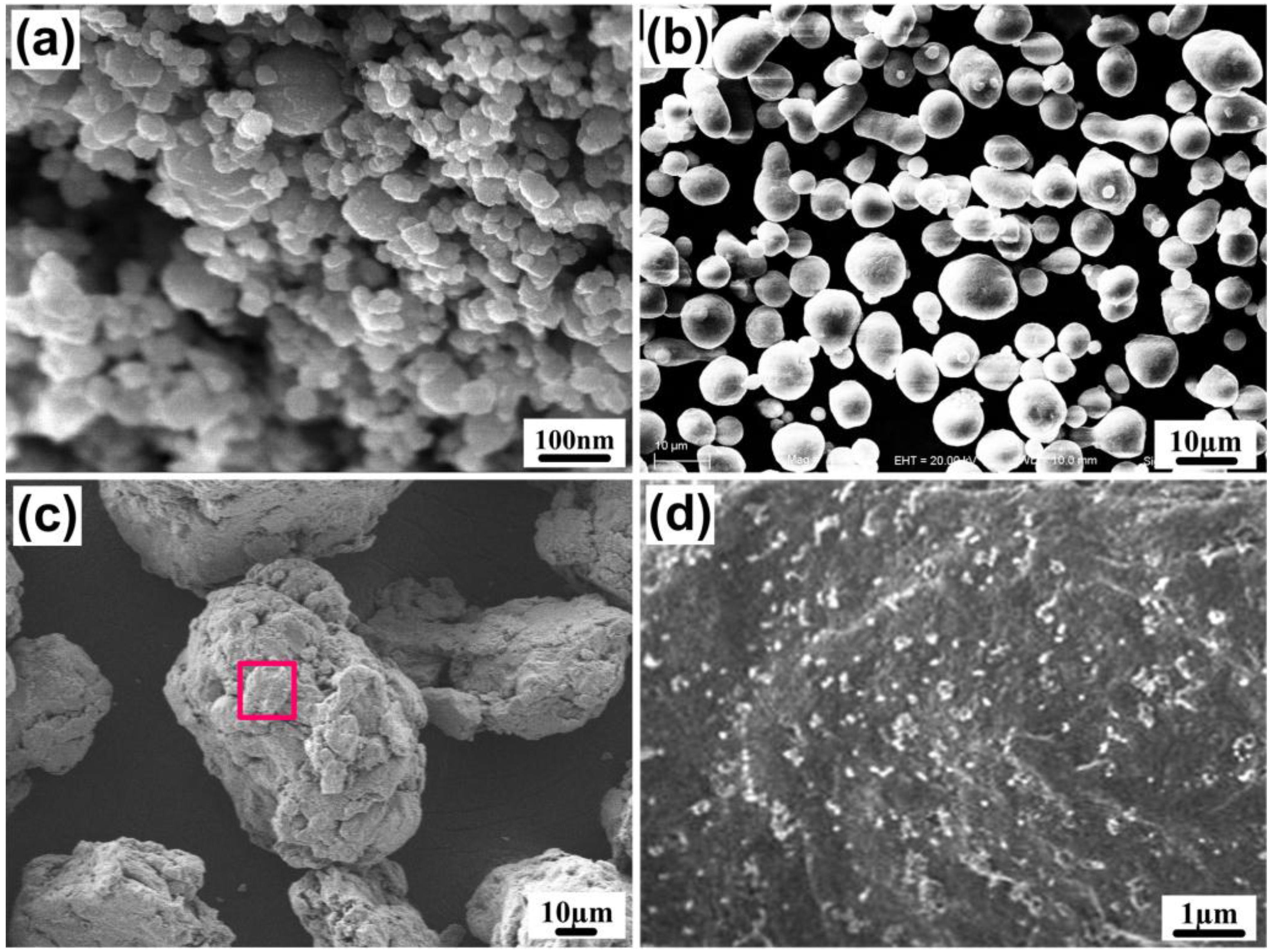
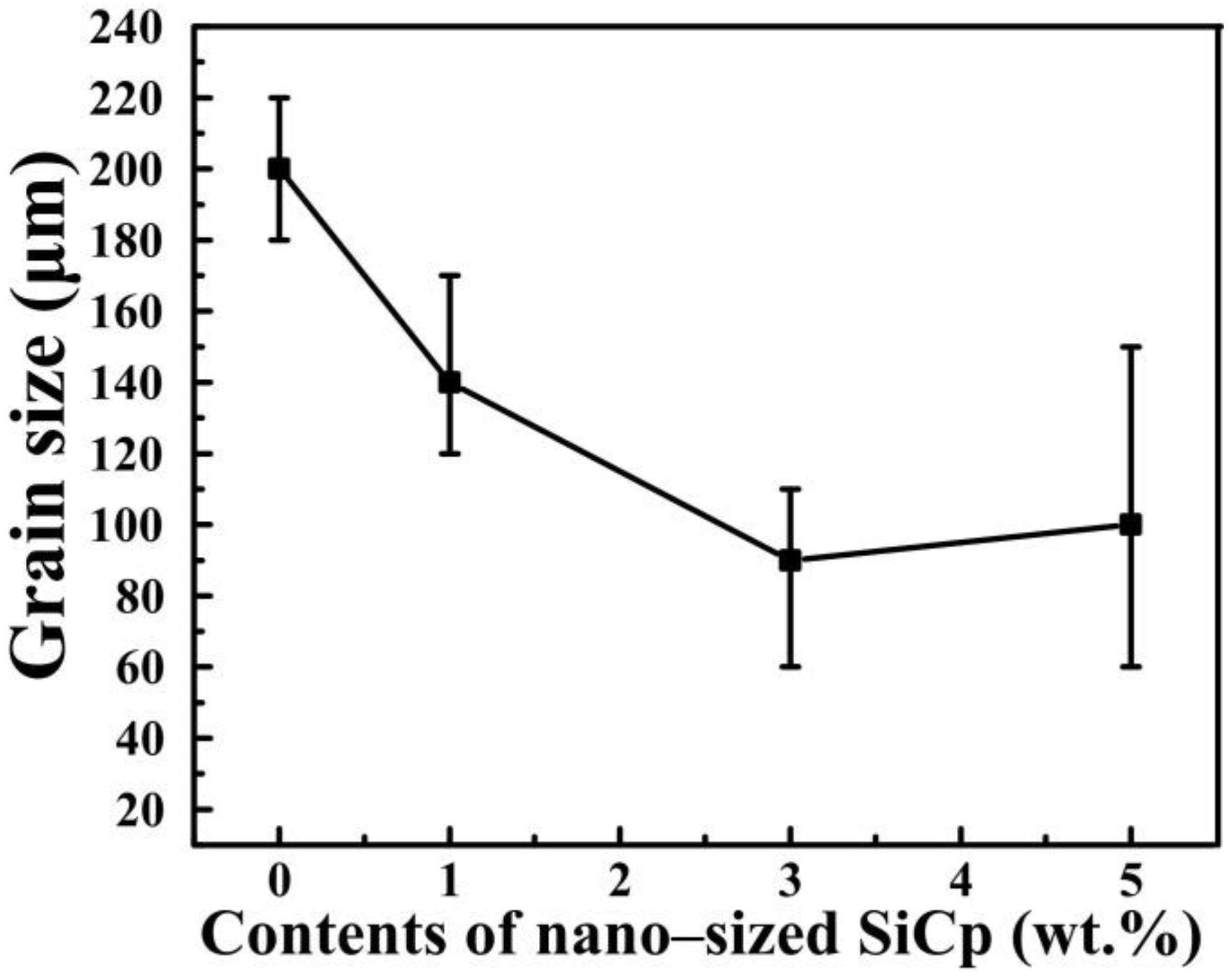
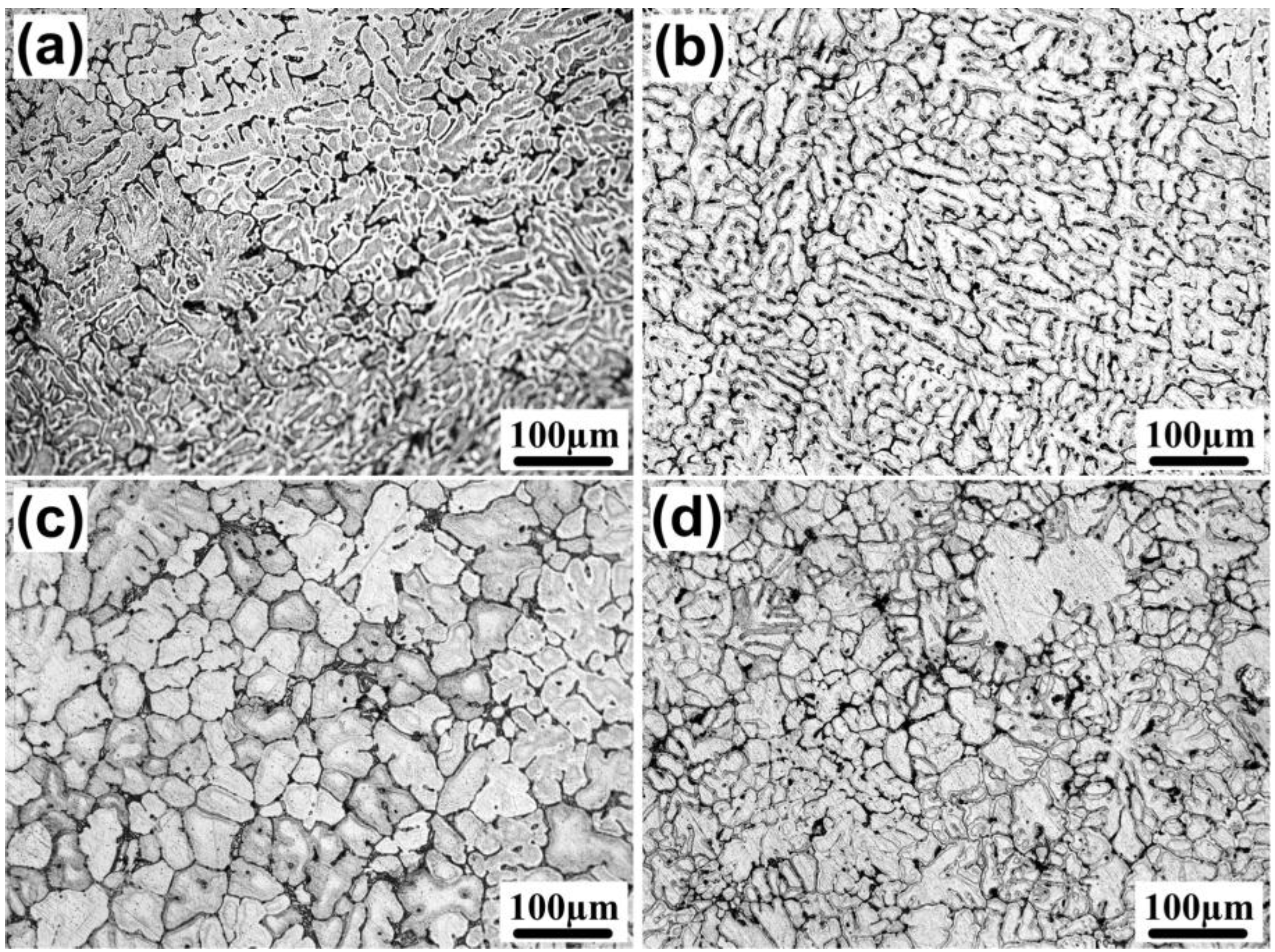
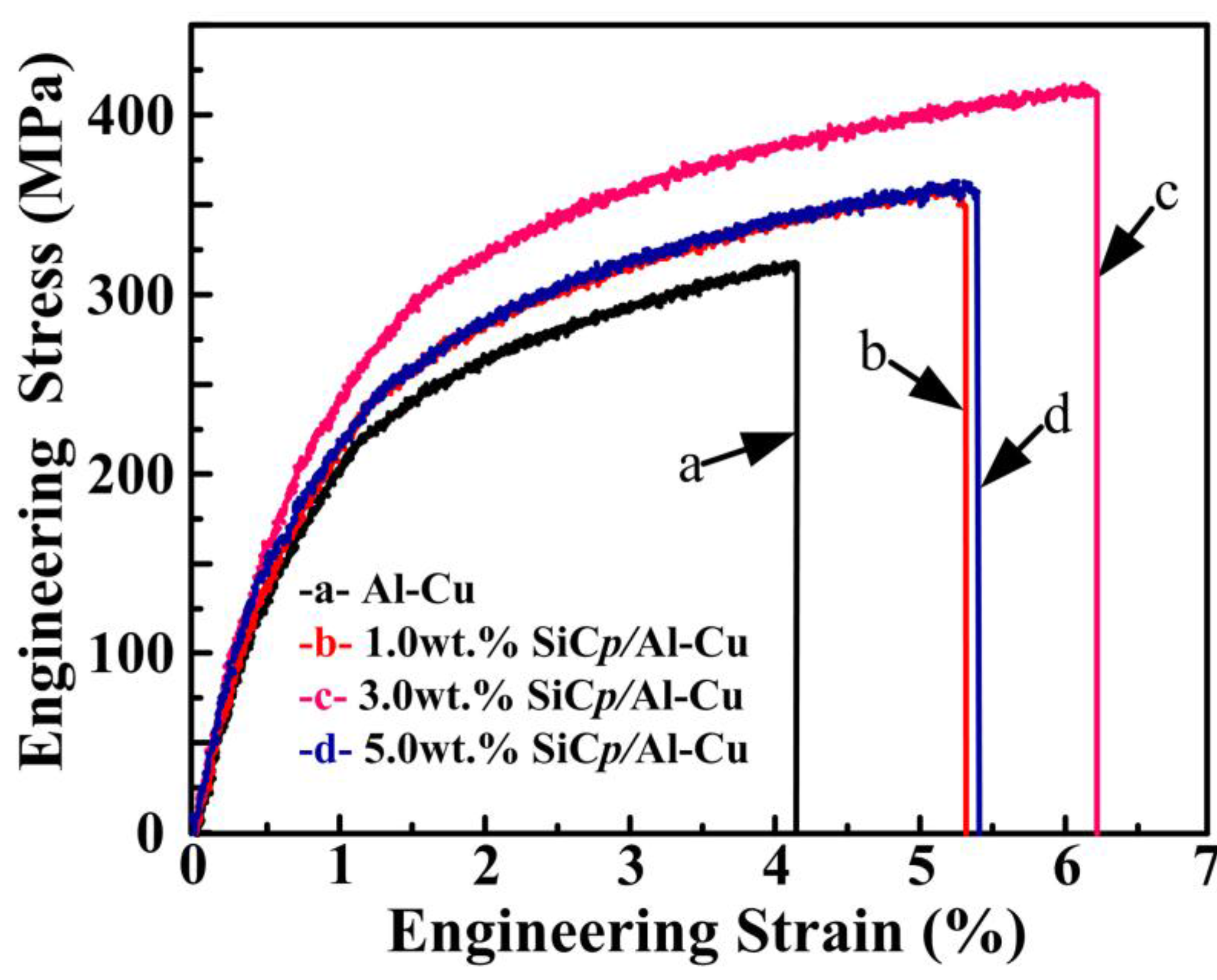
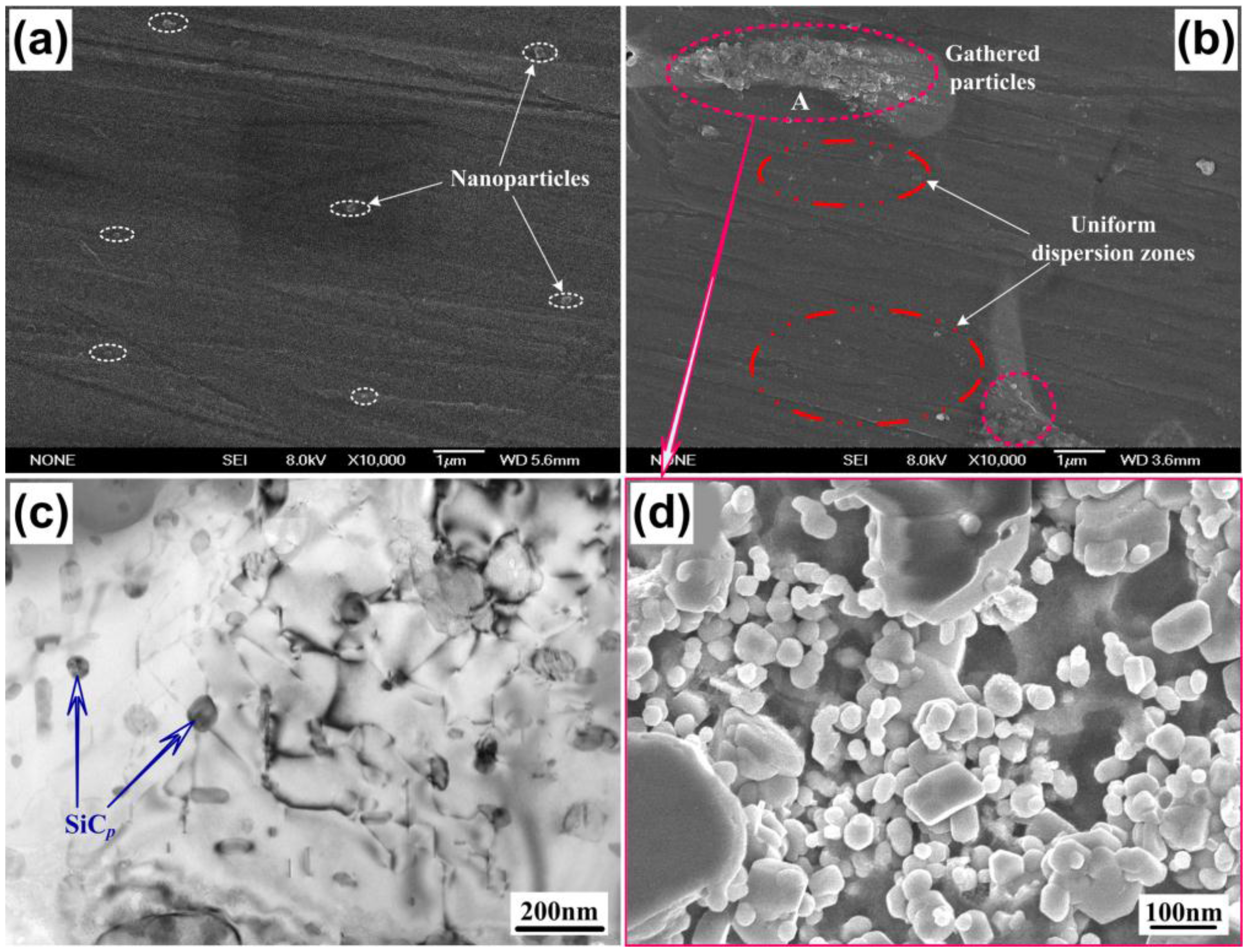
| SiCp (wt. %) | σ0.2 (MPa) | σb (MPa) | ε (%) |
|---|---|---|---|
| 0 | 4. | ||
| 1 | 5. | ||
| 3 | 6. | ||
| 5 | 5. |
© 2017 by the authors. Licensee MDPI, Basel, Switzerland. This article is an open access article distributed under the terms and conditions of the Creative Commons Attribution (CC BY) license ( http://creativecommons.org/licenses/by/4.0/).
Share and Cite
Qiu, F.; Gao, X.; Tang, J.; Gao, Y.-Y.; Shu, S.-L.; Han, X.; Li, Q.; Jiang, Q.-C. Microstructures and Tensile Properties of Al–Cu Matrix Composites Reinforced with Nano-Sized SiCp Fabricated by Semisolid Stirring Process. Metals 2017, 7, 49. https://doi.org/10.3390/met7020049
Qiu F, Gao X, Tang J, Gao Y-Y, Shu S-L, Han X, Li Q, Jiang Q-C. Microstructures and Tensile Properties of Al–Cu Matrix Composites Reinforced with Nano-Sized SiCp Fabricated by Semisolid Stirring Process. Metals. 2017; 7(2):49. https://doi.org/10.3390/met7020049
Chicago/Turabian StyleQiu, Feng, Xiang Gao, Jian Tang, Yu-Yang Gao, Shi-Li Shu, Xue Han, Qiang Li, and Qi-Chuan Jiang. 2017. "Microstructures and Tensile Properties of Al–Cu Matrix Composites Reinforced with Nano-Sized SiCp Fabricated by Semisolid Stirring Process" Metals 7, no. 2: 49. https://doi.org/10.3390/met7020049




